Employability Skills in Healthcare: Performance, Team Dynamics
VerifiedAdded on 2024/06/28
|26
|5142
|344
Report
AI Summary
This report provides a comprehensive analysis of employability skills within the healthcare sector, emphasizing the importance of these skills for organizational success and employee development. It outlines key responsibilities and performance objectives for healthcare professionals, highlighting the need for self-management, quality service delivery, and ethical work practices. The report also explores methods for evaluating and improving individual performance, including strategies for personal growth, adaptability, and effective feedback mechanisms. Furthermore, it delves into motivational theories and techniques for enhancing employee engagement and performance through both monetary and non-monetary incentives. The analysis extends to interpersonal and transferable skills, examining problem-solving approaches, communication styles, and time management strategies crucial for healthcare teams. The report concludes by addressing team dynamics, emphasizing the significance of team building, conflict resolution, and effective leadership for fostering a collaborative and productive work environment. This detailed exploration aims to equip healthcare organizations with actionable insights for cultivating a skilled and motivated workforce, ultimately improving the quality of care and achieving a competitive advantage.
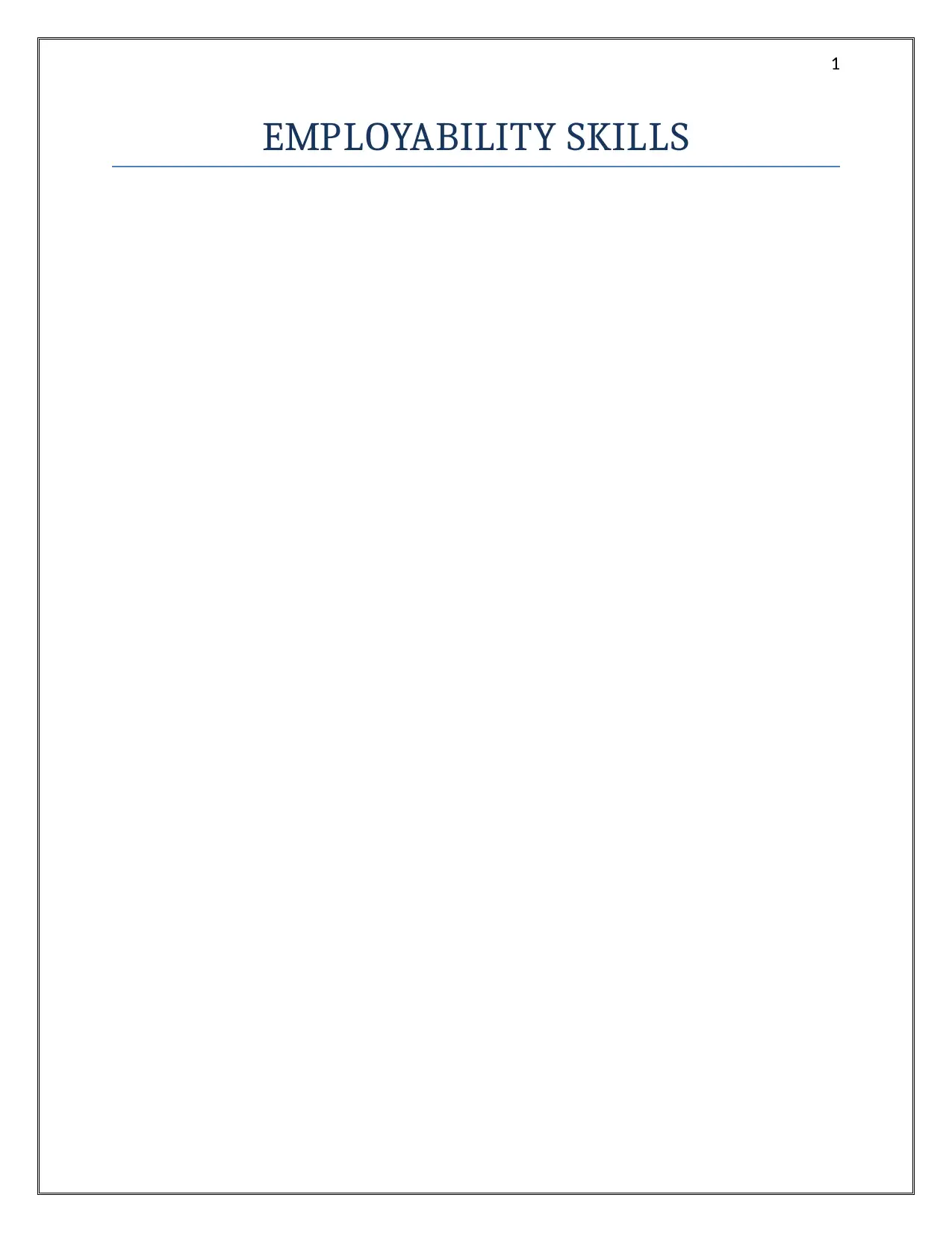
1
EMPLOYABILITY SKILLS
EMPLOYABILITY SKILLS
Paraphrase This Document
Need a fresh take? Get an instant paraphrase of this document with our AI Paraphraser
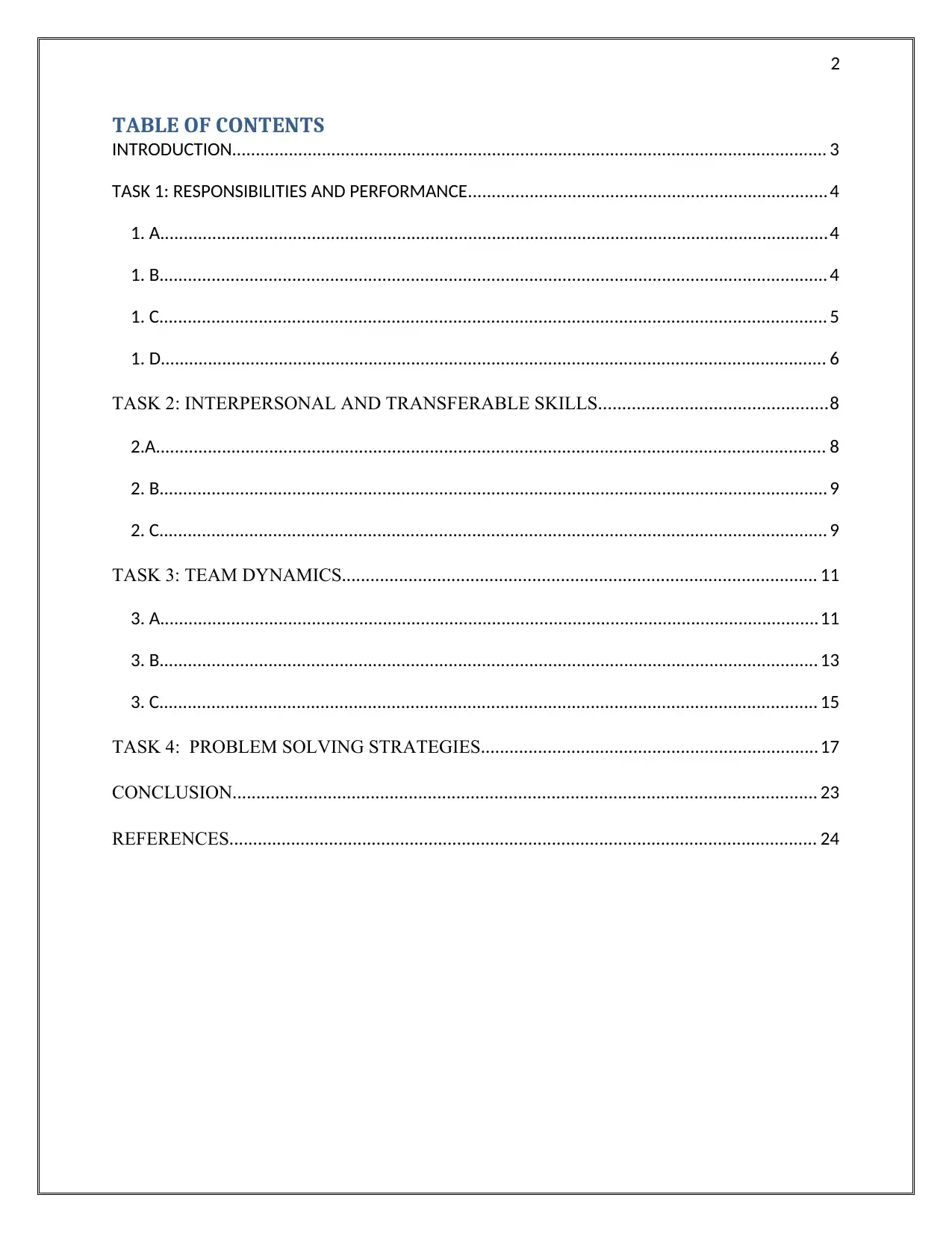
2
TABLE OF CONTENTS
INTRODUCTION.............................................................................................................................. 3
TASK 1: RESPONSIBILITIES AND PERFORMANCE............................................................................4
1. A.............................................................................................................................................4
1. B............................................................................................................................................. 4
1. C............................................................................................................................................. 5
1. D............................................................................................................................................. 6
TASK 2: INTERPERSONAL AND TRANSFERABLE SKILLS................................................8
2.A.............................................................................................................................................. 8
2. B............................................................................................................................................. 9
2. C............................................................................................................................................. 9
TASK 3: TEAM DYNAMICS.................................................................................................... 11
3. A...........................................................................................................................................11
3. B........................................................................................................................................... 13
3. C........................................................................................................................................... 15
TASK 4: PROBLEM SOLVING STRATEGIES.......................................................................17
CONCLUSION........................................................................................................................... 23
REFERENCES............................................................................................................................ 24
TABLE OF CONTENTS
INTRODUCTION.............................................................................................................................. 3
TASK 1: RESPONSIBILITIES AND PERFORMANCE............................................................................4
1. A.............................................................................................................................................4
1. B............................................................................................................................................. 4
1. C............................................................................................................................................. 5
1. D............................................................................................................................................. 6
TASK 2: INTERPERSONAL AND TRANSFERABLE SKILLS................................................8
2.A.............................................................................................................................................. 8
2. B............................................................................................................................................. 9
2. C............................................................................................................................................. 9
TASK 3: TEAM DYNAMICS.................................................................................................... 11
3. A...........................................................................................................................................11
3. B........................................................................................................................................... 13
3. C........................................................................................................................................... 15
TASK 4: PROBLEM SOLVING STRATEGIES.......................................................................17
CONCLUSION........................................................................................................................... 23
REFERENCES............................................................................................................................ 24
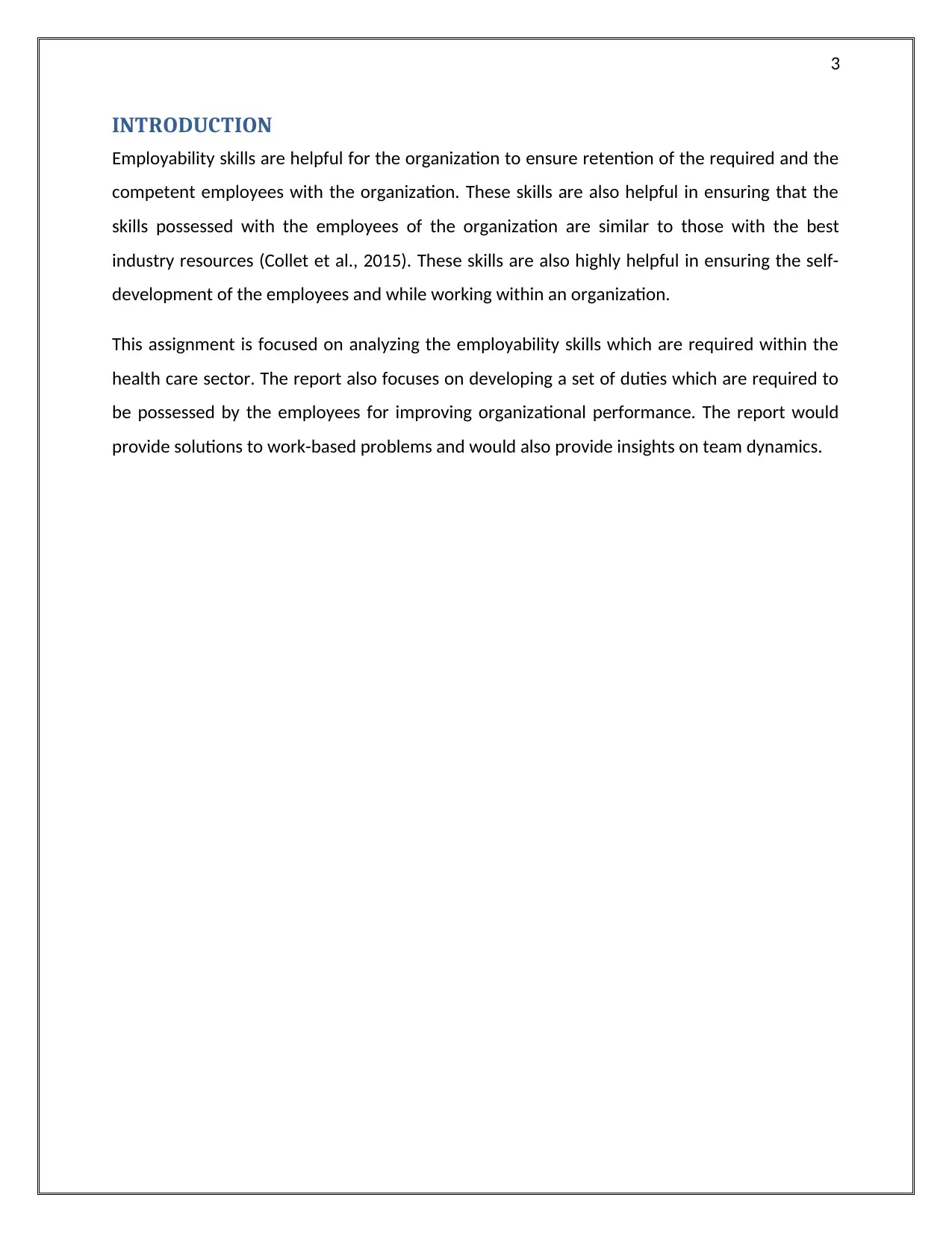
3
INTRODUCTION
Employability skills are helpful for the organization to ensure retention of the required and the
competent employees with the organization. These skills are also helpful in ensuring that the
skills possessed with the employees of the organization are similar to those with the best
industry resources (Collet et al., 2015). These skills are also highly helpful in ensuring the self-
development of the employees and while working within an organization.
This assignment is focused on analyzing the employability skills which are required within the
health care sector. The report also focuses on developing a set of duties which are required to
be possessed by the employees for improving organizational performance. The report would
provide solutions to work-based problems and would also provide insights on team dynamics.
INTRODUCTION
Employability skills are helpful for the organization to ensure retention of the required and the
competent employees with the organization. These skills are also helpful in ensuring that the
skills possessed with the employees of the organization are similar to those with the best
industry resources (Collet et al., 2015). These skills are also highly helpful in ensuring the self-
development of the employees and while working within an organization.
This assignment is focused on analyzing the employability skills which are required within the
health care sector. The report also focuses on developing a set of duties which are required to
be possessed by the employees for improving organizational performance. The report would
provide solutions to work-based problems and would also provide insights on team dynamics.
⊘ This is a preview!⊘
Do you want full access?
Subscribe today to unlock all pages.

Trusted by 1+ million students worldwide
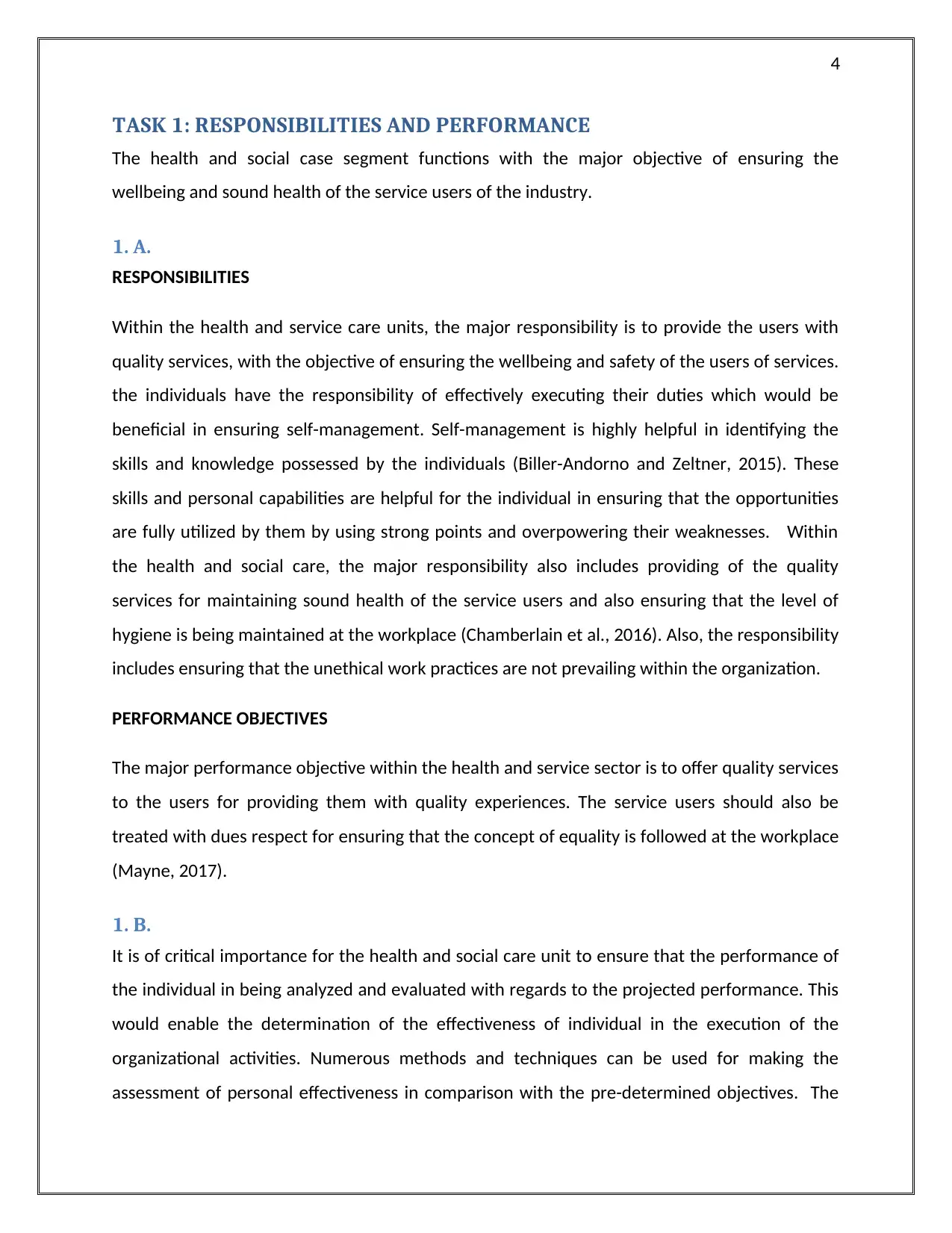
4
TASK 1: RESPONSIBILITIES AND PERFORMANCE
The health and social case segment functions with the major objective of ensuring the
wellbeing and sound health of the service users of the industry.
1. A.
RESPONSIBILITIES
Within the health and service care units, the major responsibility is to provide the users with
quality services, with the objective of ensuring the wellbeing and safety of the users of services.
the individuals have the responsibility of effectively executing their duties which would be
beneficial in ensuring self-management. Self-management is highly helpful in identifying the
skills and knowledge possessed by the individuals (Biller-Andorno and Zeltner, 2015). These
skills and personal capabilities are helpful for the individual in ensuring that the opportunities
are fully utilized by them by using strong points and overpowering their weaknesses. Within
the health and social care, the major responsibility also includes providing of the quality
services for maintaining sound health of the service users and also ensuring that the level of
hygiene is being maintained at the workplace (Chamberlain et al., 2016). Also, the responsibility
includes ensuring that the unethical work practices are not prevailing within the organization.
PERFORMANCE OBJECTIVES
The major performance objective within the health and service sector is to offer quality services
to the users for providing them with quality experiences. The service users should also be
treated with dues respect for ensuring that the concept of equality is followed at the workplace
(Mayne, 2017).
1. B.
It is of critical importance for the health and social care unit to ensure that the performance of
the individual in being analyzed and evaluated with regards to the projected performance. This
would enable the determination of the effectiveness of individual in the execution of the
organizational activities. Numerous methods and techniques can be used for making the
assessment of personal effectiveness in comparison with the pre-determined objectives. The
TASK 1: RESPONSIBILITIES AND PERFORMANCE
The health and social case segment functions with the major objective of ensuring the
wellbeing and sound health of the service users of the industry.
1. A.
RESPONSIBILITIES
Within the health and service care units, the major responsibility is to provide the users with
quality services, with the objective of ensuring the wellbeing and safety of the users of services.
the individuals have the responsibility of effectively executing their duties which would be
beneficial in ensuring self-management. Self-management is highly helpful in identifying the
skills and knowledge possessed by the individuals (Biller-Andorno and Zeltner, 2015). These
skills and personal capabilities are helpful for the individual in ensuring that the opportunities
are fully utilized by them by using strong points and overpowering their weaknesses. Within
the health and social care, the major responsibility also includes providing of the quality
services for maintaining sound health of the service users and also ensuring that the level of
hygiene is being maintained at the workplace (Chamberlain et al., 2016). Also, the responsibility
includes ensuring that the unethical work practices are not prevailing within the organization.
PERFORMANCE OBJECTIVES
The major performance objective within the health and service sector is to offer quality services
to the users for providing them with quality experiences. The service users should also be
treated with dues respect for ensuring that the concept of equality is followed at the workplace
(Mayne, 2017).
1. B.
It is of critical importance for the health and social care unit to ensure that the performance of
the individual in being analyzed and evaluated with regards to the projected performance. This
would enable the determination of the effectiveness of individual in the execution of the
organizational activities. Numerous methods and techniques can be used for making the
assessment of personal effectiveness in comparison with the pre-determined objectives. The
Paraphrase This Document
Need a fresh take? Get an instant paraphrase of this document with our AI Paraphraser

5
evaluation provides a clear and detailed idea about the skills and knowledge possessed by the
individual (Taylor, 2016). This assessment is also highly beneficial in determining the training
and development needs which would contribute significantly towards the improvement in the
effectiveness of the individuals.
The other factors should also be taken into considerations which are related to the assigned
roles. These factors majorly comprise up of the interpersonal skills of the individuals which
explain the effectiveness of the communication skills and personal behaviour of the individual
(Billett, 2019). It also takes into consideration the communication skills, which depicts the mode
of communication adopted and its effectiveness.
All these would be highly beneficial for the health and social care worker in ensuring that their
duties are being performed with full efficiency. Thus, it can be said that as a health and social
care worker, it is very essential for the individuals to gain a detailed understanding of the
interpersonal and the communication skills which would enable them to provide quality
services (Sisodia and Agarwal, 2017). The determination of the application and execution of the
duties of the individuals is the best method of evaluating the effectiveness with which the
individuals perform their duties. This evaluation is also considered as highly important in
improving the performance and also ensuring that the gap existing within the desired and the
actual performance is being fulfilled.
1. C.
It is very essential to adopt several measures which would be helpful in improving the overall
performance and the effectiveness in the working of the individuals (Messum et al., 2015). The
recommendations which would be beneficial in improving the performance within the health
and social care are as follows:
Focus on personal growth:
With the objective of ensuring the personal development of the individuals, it is very necessary
to ensure that equal focus is being paid to all the employees within the organization and that
the problems which are being faced by them are efficiently identified (Roy et al., 2017). The
evaluation provides a clear and detailed idea about the skills and knowledge possessed by the
individual (Taylor, 2016). This assessment is also highly beneficial in determining the training
and development needs which would contribute significantly towards the improvement in the
effectiveness of the individuals.
The other factors should also be taken into considerations which are related to the assigned
roles. These factors majorly comprise up of the interpersonal skills of the individuals which
explain the effectiveness of the communication skills and personal behaviour of the individual
(Billett, 2019). It also takes into consideration the communication skills, which depicts the mode
of communication adopted and its effectiveness.
All these would be highly beneficial for the health and social care worker in ensuring that their
duties are being performed with full efficiency. Thus, it can be said that as a health and social
care worker, it is very essential for the individuals to gain a detailed understanding of the
interpersonal and the communication skills which would enable them to provide quality
services (Sisodia and Agarwal, 2017). The determination of the application and execution of the
duties of the individuals is the best method of evaluating the effectiveness with which the
individuals perform their duties. This evaluation is also considered as highly important in
improving the performance and also ensuring that the gap existing within the desired and the
actual performance is being fulfilled.
1. C.
It is very essential to adopt several measures which would be helpful in improving the overall
performance and the effectiveness in the working of the individuals (Messum et al., 2015). The
recommendations which would be beneficial in improving the performance within the health
and social care are as follows:
Focus on personal growth:
With the objective of ensuring the personal development of the individuals, it is very necessary
to ensure that equal focus is being paid to all the employees within the organization and that
the problems which are being faced by them are efficiently identified (Roy et al., 2017). The
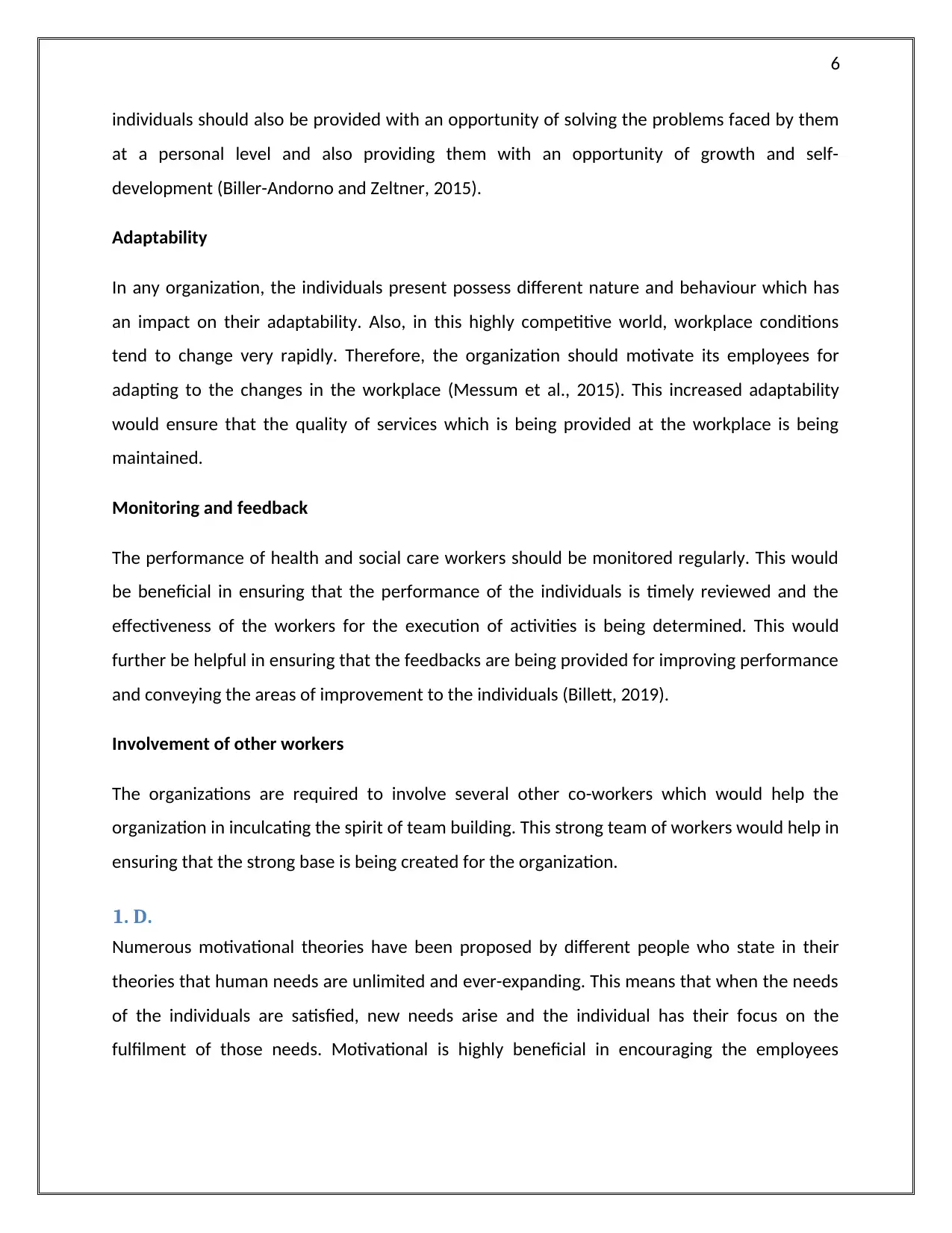
6
individuals should also be provided with an opportunity of solving the problems faced by them
at a personal level and also providing them with an opportunity of growth and self-
development (Biller-Andorno and Zeltner, 2015).
Adaptability
In any organization, the individuals present possess different nature and behaviour which has
an impact on their adaptability. Also, in this highly competitive world, workplace conditions
tend to change very rapidly. Therefore, the organization should motivate its employees for
adapting to the changes in the workplace (Messum et al., 2015). This increased adaptability
would ensure that the quality of services which is being provided at the workplace is being
maintained.
Monitoring and feedback
The performance of health and social care workers should be monitored regularly. This would
be beneficial in ensuring that the performance of the individuals is timely reviewed and the
effectiveness of the workers for the execution of activities is being determined. This would
further be helpful in ensuring that the feedbacks are being provided for improving performance
and conveying the areas of improvement to the individuals (Billett, 2019).
Involvement of other workers
The organizations are required to involve several other co-workers which would help the
organization in inculcating the spirit of team building. This strong team of workers would help in
ensuring that the strong base is being created for the organization.
1. D.
Numerous motivational theories have been proposed by different people who state in their
theories that human needs are unlimited and ever-expanding. This means that when the needs
of the individuals are satisfied, new needs arise and the individual has their focus on the
fulfilment of those needs. Motivational is highly beneficial in encouraging the employees
individuals should also be provided with an opportunity of solving the problems faced by them
at a personal level and also providing them with an opportunity of growth and self-
development (Biller-Andorno and Zeltner, 2015).
Adaptability
In any organization, the individuals present possess different nature and behaviour which has
an impact on their adaptability. Also, in this highly competitive world, workplace conditions
tend to change very rapidly. Therefore, the organization should motivate its employees for
adapting to the changes in the workplace (Messum et al., 2015). This increased adaptability
would ensure that the quality of services which is being provided at the workplace is being
maintained.
Monitoring and feedback
The performance of health and social care workers should be monitored regularly. This would
be beneficial in ensuring that the performance of the individuals is timely reviewed and the
effectiveness of the workers for the execution of activities is being determined. This would
further be helpful in ensuring that the feedbacks are being provided for improving performance
and conveying the areas of improvement to the individuals (Billett, 2019).
Involvement of other workers
The organizations are required to involve several other co-workers which would help the
organization in inculcating the spirit of team building. This strong team of workers would help in
ensuring that the strong base is being created for the organization.
1. D.
Numerous motivational theories have been proposed by different people who state in their
theories that human needs are unlimited and ever-expanding. This means that when the needs
of the individuals are satisfied, new needs arise and the individual has their focus on the
fulfilment of those needs. Motivational is highly beneficial in encouraging the employees
⊘ This is a preview!⊘
Do you want full access?
Subscribe today to unlock all pages.

Trusted by 1+ million students worldwide

7
towards the enhancement of their personal performance (Messum et al., 2017). The employees
can be motivated by providing them with several benefits.
Within the health and social care, the workers can be motivated by using several techniques
such as providing the employees with monetary and non-monetary benefits. These benefits
which are being provided by the organization to the individuals help in ensuring that the
employees and their monetary needs are being fulfilled and also that they remain satisfied with
the work done by them (Billett, 2019). This also helps in enhancing their performance owing to
the increased motivation.
When the employees are being rewarded with the non-monetary benefits, the organization can
ensure the job satisfaction of the employees. The non-monetary benefits include work
appreciation for outstanding deeds performed by them, promotions and encouragement. The
employees can also be largely involved in the decision-making process of the organization,
which would make them feel connected, and motivated (Singh and Jaykumar, 2017).
Motivation is helpful for the organization in building a skilled and highly efficient workforce and
also ensuring that competitive advantage is being provided over other players within the
environment where the firm operates.
towards the enhancement of their personal performance (Messum et al., 2017). The employees
can be motivated by providing them with several benefits.
Within the health and social care, the workers can be motivated by using several techniques
such as providing the employees with monetary and non-monetary benefits. These benefits
which are being provided by the organization to the individuals help in ensuring that the
employees and their monetary needs are being fulfilled and also that they remain satisfied with
the work done by them (Billett, 2019). This also helps in enhancing their performance owing to
the increased motivation.
When the employees are being rewarded with the non-monetary benefits, the organization can
ensure the job satisfaction of the employees. The non-monetary benefits include work
appreciation for outstanding deeds performed by them, promotions and encouragement. The
employees can also be largely involved in the decision-making process of the organization,
which would make them feel connected, and motivated (Singh and Jaykumar, 2017).
Motivation is helpful for the organization in building a skilled and highly efficient workforce and
also ensuring that competitive advantage is being provided over other players within the
environment where the firm operates.
Paraphrase This Document
Need a fresh take? Get an instant paraphrase of this document with our AI Paraphraser
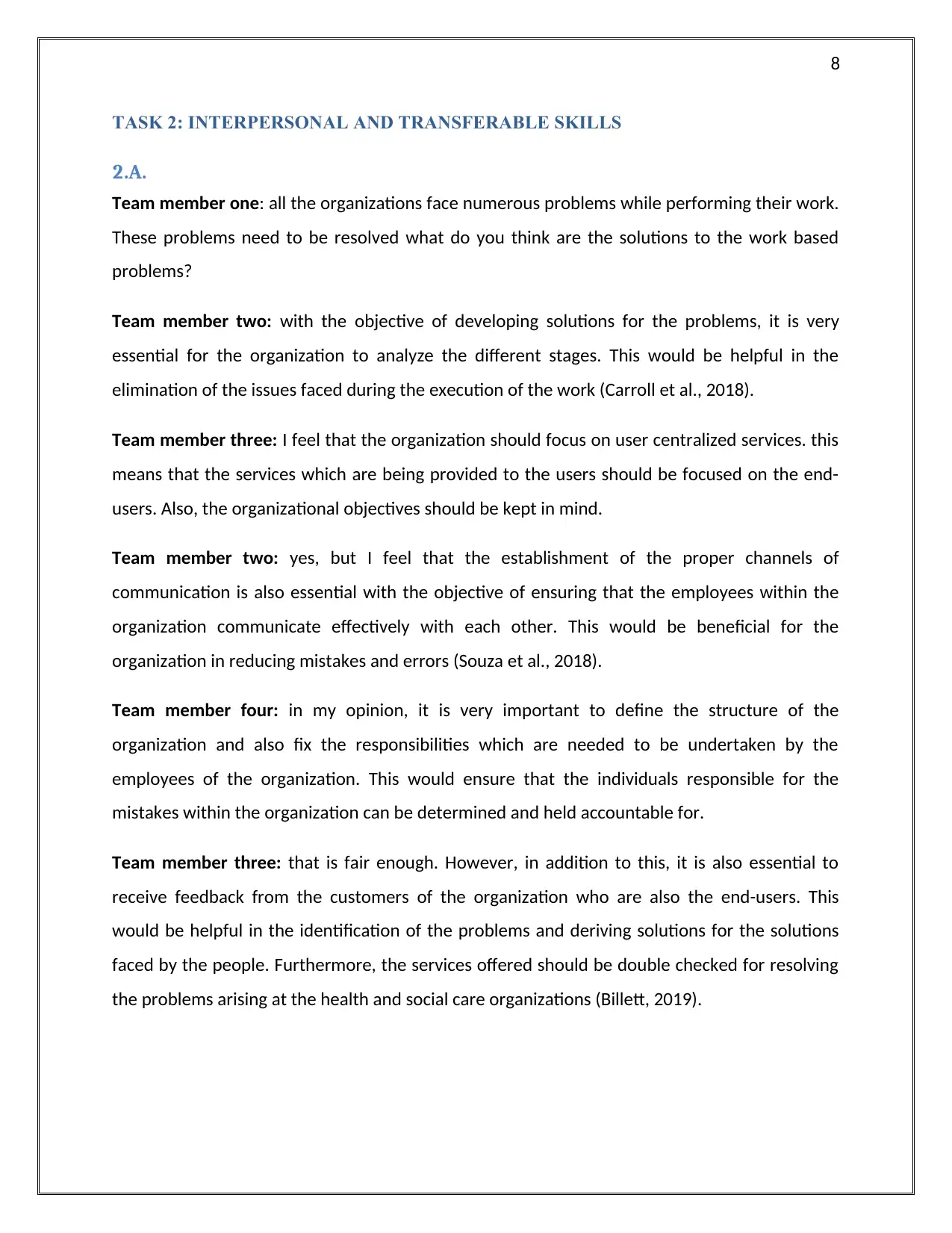
8
TASK 2: INTERPERSONAL AND TRANSFERABLE SKILLS
2.A.
Team member one: all the organizations face numerous problems while performing their work.
These problems need to be resolved what do you think are the solutions to the work based
problems?
Team member two: with the objective of developing solutions for the problems, it is very
essential for the organization to analyze the different stages. This would be helpful in the
elimination of the issues faced during the execution of the work (Carroll et al., 2018).
Team member three: I feel that the organization should focus on user centralized services. this
means that the services which are being provided to the users should be focused on the end-
users. Also, the organizational objectives should be kept in mind.
Team member two: yes, but I feel that the establishment of the proper channels of
communication is also essential with the objective of ensuring that the employees within the
organization communicate effectively with each other. This would be beneficial for the
organization in reducing mistakes and errors (Souza et al., 2018).
Team member four: in my opinion, it is very important to define the structure of the
organization and also fix the responsibilities which are needed to be undertaken by the
employees of the organization. This would ensure that the individuals responsible for the
mistakes within the organization can be determined and held accountable for.
Team member three: that is fair enough. However, in addition to this, it is also essential to
receive feedback from the customers of the organization who are also the end-users. This
would be helpful in the identification of the problems and deriving solutions for the solutions
faced by the people. Furthermore, the services offered should be double checked for resolving
the problems arising at the health and social care organizations (Billett, 2019).
TASK 2: INTERPERSONAL AND TRANSFERABLE SKILLS
2.A.
Team member one: all the organizations face numerous problems while performing their work.
These problems need to be resolved what do you think are the solutions to the work based
problems?
Team member two: with the objective of developing solutions for the problems, it is very
essential for the organization to analyze the different stages. This would be helpful in the
elimination of the issues faced during the execution of the work (Carroll et al., 2018).
Team member three: I feel that the organization should focus on user centralized services. this
means that the services which are being provided to the users should be focused on the end-
users. Also, the organizational objectives should be kept in mind.
Team member two: yes, but I feel that the establishment of the proper channels of
communication is also essential with the objective of ensuring that the employees within the
organization communicate effectively with each other. This would be beneficial for the
organization in reducing mistakes and errors (Souza et al., 2018).
Team member four: in my opinion, it is very important to define the structure of the
organization and also fix the responsibilities which are needed to be undertaken by the
employees of the organization. This would ensure that the individuals responsible for the
mistakes within the organization can be determined and held accountable for.
Team member three: that is fair enough. However, in addition to this, it is also essential to
receive feedback from the customers of the organization who are also the end-users. This
would be helpful in the identification of the problems and deriving solutions for the solutions
faced by the people. Furthermore, the services offered should be double checked for resolving
the problems arising at the health and social care organizations (Billett, 2019).
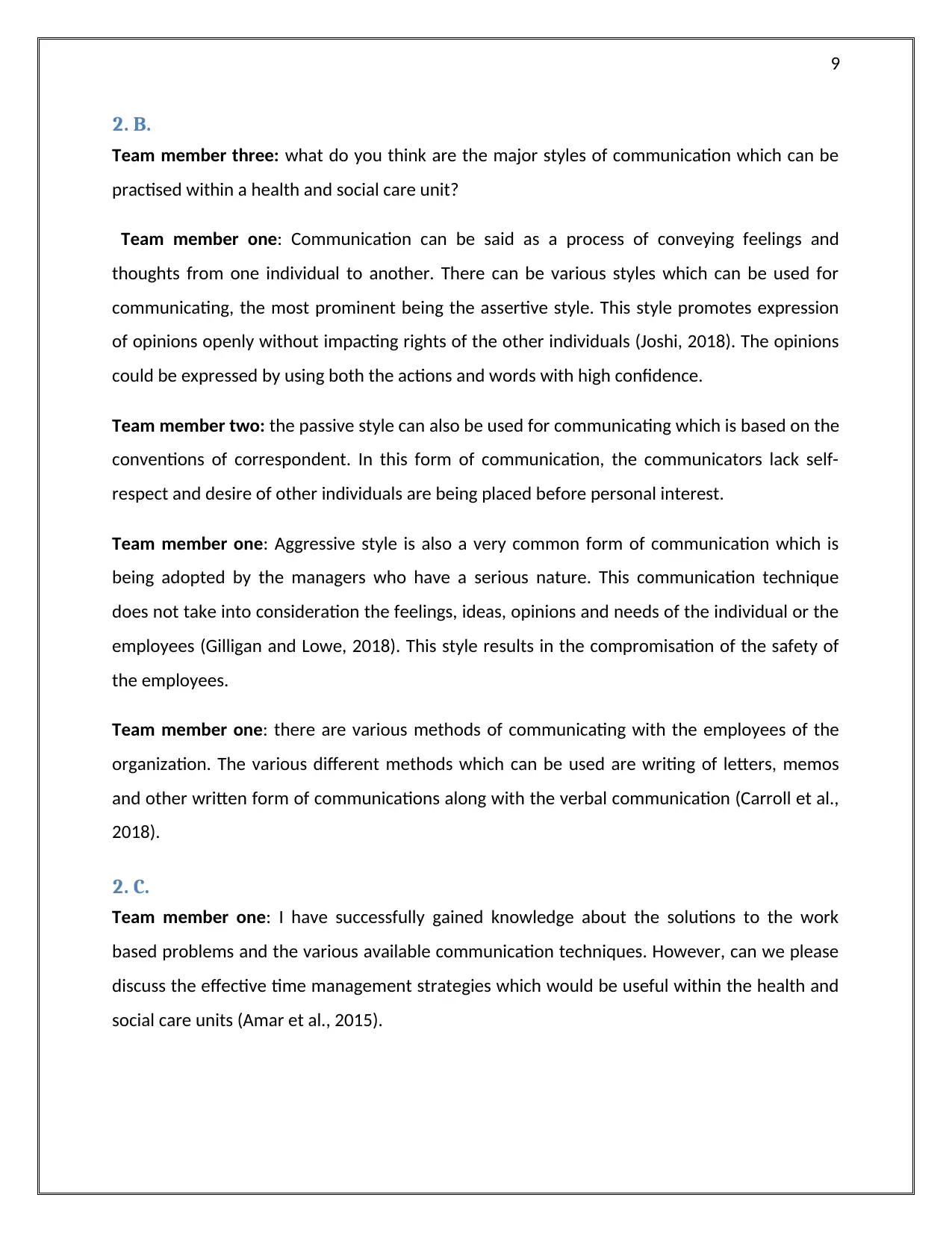
9
2. B.
Team member three: what do you think are the major styles of communication which can be
practised within a health and social care unit?
Team member one: Communication can be said as a process of conveying feelings and
thoughts from one individual to another. There can be various styles which can be used for
communicating, the most prominent being the assertive style. This style promotes expression
of opinions openly without impacting rights of the other individuals (Joshi, 2018). The opinions
could be expressed by using both the actions and words with high confidence.
Team member two: the passive style can also be used for communicating which is based on the
conventions of correspondent. In this form of communication, the communicators lack self-
respect and desire of other individuals are being placed before personal interest.
Team member one: Aggressive style is also a very common form of communication which is
being adopted by the managers who have a serious nature. This communication technique
does not take into consideration the feelings, ideas, opinions and needs of the individual or the
employees (Gilligan and Lowe, 2018). This style results in the compromisation of the safety of
the employees.
Team member one: there are various methods of communicating with the employees of the
organization. The various different methods which can be used are writing of letters, memos
and other written form of communications along with the verbal communication (Carroll et al.,
2018).
2. C.
Team member one: I have successfully gained knowledge about the solutions to the work
based problems and the various available communication techniques. However, can we please
discuss the effective time management strategies which would be useful within the health and
social care units (Amar et al., 2015).
2. B.
Team member three: what do you think are the major styles of communication which can be
practised within a health and social care unit?
Team member one: Communication can be said as a process of conveying feelings and
thoughts from one individual to another. There can be various styles which can be used for
communicating, the most prominent being the assertive style. This style promotes expression
of opinions openly without impacting rights of the other individuals (Joshi, 2018). The opinions
could be expressed by using both the actions and words with high confidence.
Team member two: the passive style can also be used for communicating which is based on the
conventions of correspondent. In this form of communication, the communicators lack self-
respect and desire of other individuals are being placed before personal interest.
Team member one: Aggressive style is also a very common form of communication which is
being adopted by the managers who have a serious nature. This communication technique
does not take into consideration the feelings, ideas, opinions and needs of the individual or the
employees (Gilligan and Lowe, 2018). This style results in the compromisation of the safety of
the employees.
Team member one: there are various methods of communicating with the employees of the
organization. The various different methods which can be used are writing of letters, memos
and other written form of communications along with the verbal communication (Carroll et al.,
2018).
2. C.
Team member one: I have successfully gained knowledge about the solutions to the work
based problems and the various available communication techniques. However, can we please
discuss the effective time management strategies which would be useful within the health and
social care units (Amar et al., 2015).
⊘ This is a preview!⊘
Do you want full access?
Subscribe today to unlock all pages.

Trusted by 1+ million students worldwide
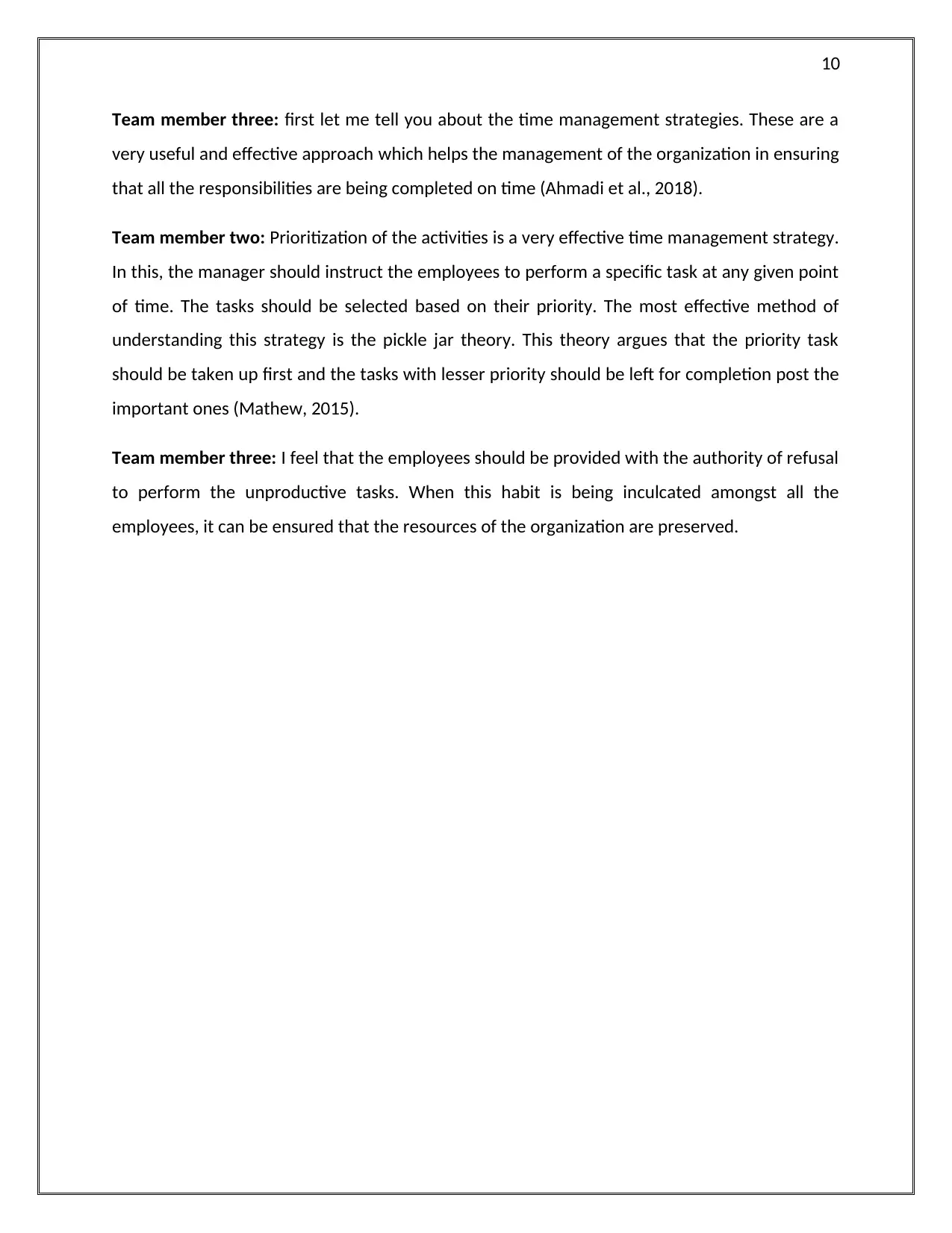
10
Team member three: first let me tell you about the time management strategies. These are a
very useful and effective approach which helps the management of the organization in ensuring
that all the responsibilities are being completed on time (Ahmadi et al., 2018).
Team member two: Prioritization of the activities is a very effective time management strategy.
In this, the manager should instruct the employees to perform a specific task at any given point
of time. The tasks should be selected based on their priority. The most effective method of
understanding this strategy is the pickle jar theory. This theory argues that the priority task
should be taken up first and the tasks with lesser priority should be left for completion post the
important ones (Mathew, 2015).
Team member three: I feel that the employees should be provided with the authority of refusal
to perform the unproductive tasks. When this habit is being inculcated amongst all the
employees, it can be ensured that the resources of the organization are preserved.
Team member three: first let me tell you about the time management strategies. These are a
very useful and effective approach which helps the management of the organization in ensuring
that all the responsibilities are being completed on time (Ahmadi et al., 2018).
Team member two: Prioritization of the activities is a very effective time management strategy.
In this, the manager should instruct the employees to perform a specific task at any given point
of time. The tasks should be selected based on their priority. The most effective method of
understanding this strategy is the pickle jar theory. This theory argues that the priority task
should be taken up first and the tasks with lesser priority should be left for completion post the
important ones (Mathew, 2015).
Team member three: I feel that the employees should be provided with the authority of refusal
to perform the unproductive tasks. When this habit is being inculcated amongst all the
employees, it can be ensured that the resources of the organization are preserved.
Paraphrase This Document
Need a fresh take? Get an instant paraphrase of this document with our AI Paraphraser
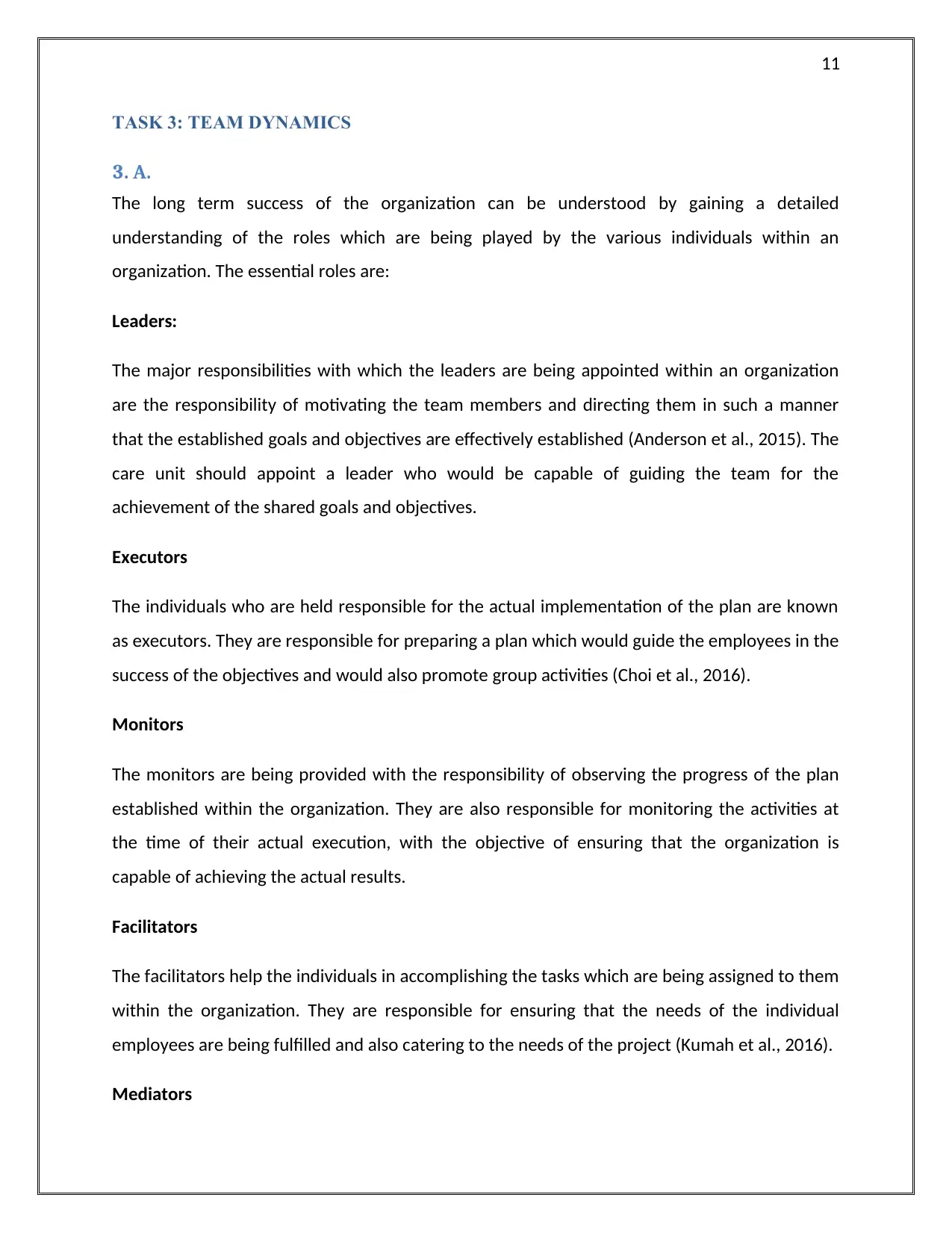
11
TASK 3: TEAM DYNAMICS
3. A.
The long term success of the organization can be understood by gaining a detailed
understanding of the roles which are being played by the various individuals within an
organization. The essential roles are:
Leaders:
The major responsibilities with which the leaders are being appointed within an organization
are the responsibility of motivating the team members and directing them in such a manner
that the established goals and objectives are effectively established (Anderson et al., 2015). The
care unit should appoint a leader who would be capable of guiding the team for the
achievement of the shared goals and objectives.
Executors
The individuals who are held responsible for the actual implementation of the plan are known
as executors. They are responsible for preparing a plan which would guide the employees in the
success of the objectives and would also promote group activities (Choi et al., 2016).
Monitors
The monitors are being provided with the responsibility of observing the progress of the plan
established within the organization. They are also responsible for monitoring the activities at
the time of their actual execution, with the objective of ensuring that the organization is
capable of achieving the actual results.
Facilitators
The facilitators help the individuals in accomplishing the tasks which are being assigned to them
within the organization. They are responsible for ensuring that the needs of the individual
employees are being fulfilled and also catering to the needs of the project (Kumah et al., 2016).
Mediators
TASK 3: TEAM DYNAMICS
3. A.
The long term success of the organization can be understood by gaining a detailed
understanding of the roles which are being played by the various individuals within an
organization. The essential roles are:
Leaders:
The major responsibilities with which the leaders are being appointed within an organization
are the responsibility of motivating the team members and directing them in such a manner
that the established goals and objectives are effectively established (Anderson et al., 2015). The
care unit should appoint a leader who would be capable of guiding the team for the
achievement of the shared goals and objectives.
Executors
The individuals who are held responsible for the actual implementation of the plan are known
as executors. They are responsible for preparing a plan which would guide the employees in the
success of the objectives and would also promote group activities (Choi et al., 2016).
Monitors
The monitors are being provided with the responsibility of observing the progress of the plan
established within the organization. They are also responsible for monitoring the activities at
the time of their actual execution, with the objective of ensuring that the organization is
capable of achieving the actual results.
Facilitators
The facilitators help the individuals in accomplishing the tasks which are being assigned to them
within the organization. They are responsible for ensuring that the needs of the individual
employees are being fulfilled and also catering to the needs of the project (Kumah et al., 2016).
Mediators
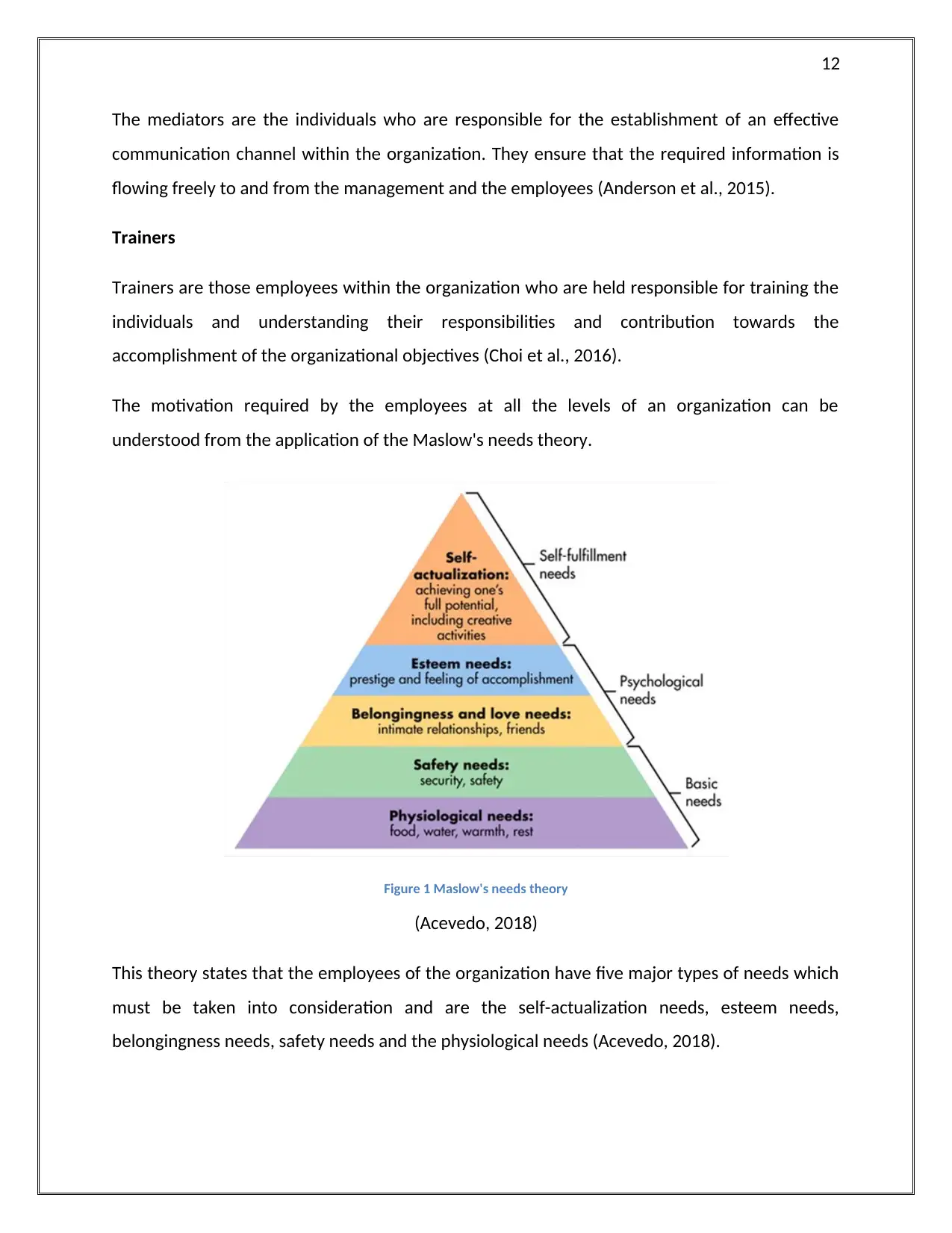
12
The mediators are the individuals who are responsible for the establishment of an effective
communication channel within the organization. They ensure that the required information is
flowing freely to and from the management and the employees (Anderson et al., 2015).
Trainers
Trainers are those employees within the organization who are held responsible for training the
individuals and understanding their responsibilities and contribution towards the
accomplishment of the organizational objectives (Choi et al., 2016).
The motivation required by the employees at all the levels of an organization can be
understood from the application of the Maslow's needs theory.
Figure 1 Maslow's needs theory
(Acevedo, 2018)
This theory states that the employees of the organization have five major types of needs which
must be taken into consideration and are the self-actualization needs, esteem needs,
belongingness needs, safety needs and the physiological needs (Acevedo, 2018).
The mediators are the individuals who are responsible for the establishment of an effective
communication channel within the organization. They ensure that the required information is
flowing freely to and from the management and the employees (Anderson et al., 2015).
Trainers
Trainers are those employees within the organization who are held responsible for training the
individuals and understanding their responsibilities and contribution towards the
accomplishment of the organizational objectives (Choi et al., 2016).
The motivation required by the employees at all the levels of an organization can be
understood from the application of the Maslow's needs theory.
Figure 1 Maslow's needs theory
(Acevedo, 2018)
This theory states that the employees of the organization have five major types of needs which
must be taken into consideration and are the self-actualization needs, esteem needs,
belongingness needs, safety needs and the physiological needs (Acevedo, 2018).
⊘ This is a preview!⊘
Do you want full access?
Subscribe today to unlock all pages.

Trusted by 1+ million students worldwide
1 out of 26
Related Documents
Your All-in-One AI-Powered Toolkit for Academic Success.
+13062052269
info@desklib.com
Available 24*7 on WhatsApp / Email
![[object Object]](/_next/static/media/star-bottom.7253800d.svg)
Unlock your academic potential
Copyright © 2020–2025 A2Z Services. All Rights Reserved. Developed and managed by ZUCOL.



